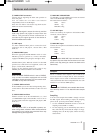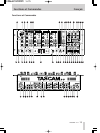
TASCAM X-17 7
Features and controls English
y C.F CURVE
Allows you to adjust the cross-fader response curve from
soft (counter-clockwise) to hard (clockwise).
u C.F REVERSE
Sets the direction of the cross-fader.
When in the OFF, position, moving the cross-fader
toward A increases the volume of the A signal and
moving the cross-fader toward B increases the volume of
the B signal. The ON setting reverses this
i Meters
This pair of peak meters indicates either the post-fader
(PGM or MASTER) MASTER signal level in stereo, or
the mono CUE signal levels.
o Meter selection switch (L/R –CUE/PROG)
Switches the meter indication between the MASTER
program (the switch is up) and the CUE signals (the
switch is depressed).
p EFFECTS ON switch and indicator
When this switch is on, the indicator lights, and the
master external effect loop is active.
a MASTER fader
Adjusts the level of the signal from the MASTER
OUTPUT jacks (both the balanced XLR and the
unbalanced RCA connectors).
s AUX IN LEVEL
Adjusts the level of the signals from the AUX IN jacks.
d AUX IN
Use these unbalanced RCA connectors to connect line
level equipment, such as CD players, cassette decks,
DAT decks, MD players, or another X-17, etc. This input
signal is input immediately pre-MASTER fader.
f AUX OUT LEVEL
Adjusts the signal level output from the AUX OUTPUT
jacks.
g BOOTH OUT LEVEL
Adjusts the signal level output from the BOOTH
OUTPUT jacks.
h REC OUTPUT
These unbalanced RCA jacks output the pre-MASTER
fader signal. This can be useful for a number of purposes:
for example, you could connect a recorder to these jacks,
and record your live performance without the MASTER
level affecting the recording.
j PRE/POST insert switch for REC OUT
This switch controls what is output from the REC OUT
jacks. When this switch is in the PRE setting (the switch
is depressed):
The four PGM signals and the sampler signal,
without the master insert loop.
In the POST setting:
The four PGM signals and the sampler signal,
with the master insert loop, the AUX IN signal,
and both the MAIN and AUX MIC signals.
k CompactFlash
TM
card slot
This slot holds a CompactFlash card which you can use
to save sampled sounds from the X-17’s internal memory,
and to load them into the X-17’s internal memory. This
allows you to carry your favorite samples in a compact,
robust format.
The card can only be inserted in one direction. Press the
eject button to the right of the slot to eject the card.
Cover this slot using the attached protective cover when it
is not in use.
See the section on the sampler below for full details of
how to use the card and the sampler.
CompactFlash is a trademark of the CompactFlash
Association.
l SAMPLER SOURCE selector
SAVE: Saves the X-17’s internal sample data to the
CompactFlash card.
LOAD: Loads sample data from the CompactFlash card
into the X-17’s internal memory.
MIC, 1-4: Select the sampling source (the MIC inputs or
any of the 4 PGMs).
; SAMPLER PITCH
Adjusts the sampler’s playback pitch and speed from half
speed (SLOW) to double speed (FAST).
z SAMPLER LEVEL
Adjusts the output level of the sampler signal.
x SAMPLER CUE switch and indicator
Sends the sampler pre-LEVEL signal to the CUE monitor
(the indicator lights when this is activate).
c SAMPLER LOOP key and indicator
Toggles sampler loop play on and off (the indicator lights
when sampler loop play is active).
v IN/<- keys (IN1, IN2, IN3)
Start sample recording or playback. When the SAMPLER
SOURCE selector is set to LOAD, these keys load
sample data from the CompactFlash card.


















